Real Aperture Continuous Terahertz Imaging System and Spectral Refinement Method
Abstract
:1. Introduction
2. FMCW Theory and System Description
2.1. FMCW Radar and Measuring Principle
2.2. System Description
2.3. System Characteristic Analysis
2.3.1. Cross-Range Resolution
2.3.2. Range Resolution
3. Spectrum Correction and Refinement Method
3.1. Frequency Correction Based on Ratio Method
3.2. Zoom-FFT
3.3. Improved Refinement Spectrum Method
| Algorithm 1: Improved Refinement Spectrum Method. |
| Input: the original sampled signal , refinement multiplier , Target band , Center frequency , and then the sampling rate after decimation is , and the analyzed frequency band can be represented as . |
|
| Output: Spectrum with distinct independent dominant flaps. |
4. Results
4.1. Cross-Range Test
4.2. Range Test
4.2.1. Simulation
4.2.2. System Test
4.2.3. Application of Terahertz Detection in Ceramic Matrix Composites
5. Conclusions
Author Contributions
Funding
Institutional Review Board Statement
Informed Consent Statement
Data Availability Statement
Conflicts of Interest
References
- Ellrich, F.; Bauer, M.; Schreiner, N.; Keil, A.; Molter, D. Terahertz Quality Inspection for Automotive and Aviation Industries. J. Infrared Millim. Terahertz Waves 2020, 41, 470–489. [Google Scholar] [CrossRef]
- Akyildiz, I.; Jornet, J.; Chong, H. Terahertz band: Next frontier for wireless communications. Phys. Commun. 2014, 12, 16–32. [Google Scholar] [CrossRef]
- Pawar, A.; Sonawane, D.; Erande, K.; Derle, D. Terahertz technology and its applications. Drug Invent. Today 2013, 5, 157–163. [Google Scholar] [CrossRef]
- Kemp, M. Detecting hidden objects: Security imaging using millimetre-waves and terahertz. In Proceedings of the Conference on Advanced Video and Signal Based Surveillance, London, UK, 5–7 September 2007; pp. 7–9. [Google Scholar]
- Oh, S.; Huh, Y.; Suh, J.; Choi, J.; Haam, S.; Son, J. Cancer diagnosis by terahertz molecular imaging technique. J. Infrared Millim. Terahertz Waves 2012, 33, 74–81. [Google Scholar] [CrossRef]
- Zhang, X.; Guo, Q.; Chang, T.; Cui, H. Broadband stepped frequency modulated continuous terahertz wave tomography for nondestructive inspection of polymer materials. Polym. Test. 2019, 76, 455–463. [Google Scholar] [CrossRef]
- Rubio-Cidre, G.; Badolato, A.; Ubeda-Medina, L.; Grajal, J.; Mencia, B.; Dorta-Naranjo, B. DDS-based signal-generation architecture comparison for an imaging radar at 300 GHz. IEEE Trans. Instrum. Meas. 2015, 64, 3085–3098. [Google Scholar] [CrossRef]
- Kimmitt, M. Restrahlen to T-rays—100 years of terahertz radiation. J. Biol. Phys. 2003, 29, 77–85. [Google Scholar] [CrossRef]
- Meta, A.; Hoogeboom, P.; Ligthart, L. Signal Processing for FMCW SAR. IEEE Trans. Geosci. Remote Sens. 2007, 45, 3519–3532. [Google Scholar] [CrossRef]
- Gao, J.; Qin, Y.; Deng, B.; Wang, H.; Li, X. A novel method for 3-D millimeter-wave holographic reconstruction based on frequency interferometry techniques. IEEE Trans. Microw. Theory Tech. 2018, 66, 1579–1596. [Google Scholar] [CrossRef]
- Sengupta, K.; Nagatsuma, T.; Mittleman, D. Terahertz integrated electronic and hybrid electronic–photonic systems. Nat. Electron. 2018, 1, 622–635. [Google Scholar] [CrossRef]
- Ako, R.; Upadhyay, A.; Withayachumnankul, W.; Bhaskaran, M.; Sriram, S. Dielectrics for Terahertz Metasurfaces: Material Selection and Fabrication Techniques. Adv. Opt. Mater. 2020, 8, 1900750. [Google Scholar] [CrossRef]
- Yang, Y.; Yamagami, Y.; Yu, X.; Pitchappa, P.; Webber, J.; Zhang, B.; Fujita, M.; Nagatsuma, T.; Singh, R. Terahertz topological photonics for on-chip communication. Nat. Photonics 2020, 14, 446–451. [Google Scholar] [CrossRef]
- Alsharif, M.H. Activities, Challenges and Potential Solutions. Symmetry 2020, 12, 676. [Google Scholar] [CrossRef]
- Cooper, K.B.; Dengler, R.J.; Llombart, N.; Thomas, B.; Siegel, P.H. THz Imaging Radar for Standoff Personnel Screening. IEEE Trans. Terahertz Sci. Technol. 2011, 1, 169–182. [Google Scholar] [CrossRef]
- Stantchev, R.I.; Yu, X.; Blu, T.; Pickwell-MacPherson, E. Real-time terahertz imaging with a single-pixel detector. Nat. Commun. 2020, 11, 2535–2538. [Google Scholar] [CrossRef]
- Federici, J.F.; Schulkin, B.; Huang, F.; Gary, D.; Barat, R.; Oliveira, F.; Zimdars, D. THz imaging and sensing for security applications—Explosives, weapons and drugs. Semicond. Sci. Technol. 2005, 20, S266–S280. [Google Scholar] [CrossRef]
- Yu, C.; Fan, S.; Sun, Y.; Pickwell-MacPherson, E. The potential of terahertz imaging for cancer diagnosis: A review of investigations to date. Quant. Imaging Med. Surg. 2012, 2, 33. [Google Scholar]
- Schreiner, N.S.; Sauer-Greff, W.; Urbansky, R.; Freymann, G.V.; Friederich, F. Multilayer Thickness Measurements below the Rayleigh Limit Using FMCW Millimeter and Terahertz Waves. Sensors 2019, 19, 3910. [Google Scholar] [CrossRef]
- Cristofani, E.; Friederich, F.; Wohnsiedler, S.; Matheis, C.; Beigang, R. Non-Destructive Testing Potential Evaluation of a THz Frequency-Modulated Continuous-Wave Imager for Composite Materials Inspection. Opt. Eng. 2014, 53, 031211. [Google Scholar] [CrossRef]
- Xue, K.; Chen, Y.; Zhang, W.; Song, J.; Wang, Z.; Jin, Y.; Guo, X. Continuous Terahertz Wave Imaging for Debonding Detection and Visualization Analysis in Layered Structures. IEEE Access 2023, 11, 31607–31618. [Google Scholar] [CrossRef]
- Giovannacci, D.; Cheung, H.; Walker, G.C.; Bowen, J.W.; Martos-Levif, D.; Brissaud, D.; Cristofol, L.; Mélinge, Y. Timedomain imaging system in the terahertz range for immovable cultural heritage materials. Strain 2019, 55, e12292. [Google Scholar] [CrossRef]
- Huang, H.; Qiu, P.; Panezai, S.; Hao, S.; Zhang, D.; Yang, Y.; Ma, Y.; Gao, H.; Gao, L.; Zhang, Z.; et al. Continuous-wave terahertz high-resolution imaging via synthetic hologram extrapolation method using pyroelectric detector. Opt. Laser Technol. 2019, 120, 105683. [Google Scholar] [CrossRef]
- Wang, Q.; Zhang, X.; Xu, Y.; Gu, J.; Li, Y.; Tian, Z.; Singh, R.; Zhang, S.; Han, J.; Zhang, W. Broadband metasurface holograms: Toward complete phase and amplitude engineering. Sci. Rep. 2016, 6, 32867. [Google Scholar] [CrossRef] [PubMed]
- Niu, T.; Withayachumnankul, W.; Upadhyay, A.; Gutruf, P.; Abbott, D.; Bhaskaran, M.; Sriram, S.; Fumeaux, C. Terahertz reflectarray as a polarizing beam splitter. Opt. Express 2014, 22, 16148–16160. [Google Scholar] [CrossRef] [PubMed]
- Zhang, T.; Huang, H.; Zhang, Z.; Gao, H.; Gao, L.; Zheng, Z. Sensitive characterizations of polyvinyl chloride using terahertz time-domain spectroscopy. Infrared Phys. Technol. 2021, 118, 103878. [Google Scholar] [CrossRef]
- Liu, H.; Zhang, Z.; Zhang, X.; Yang, Y.; Zhang, Z.; Liu, X.; Wang, F.; Han, Y.; Zhang, C. Dimensionality reduction for identification of hepatic tumor samples based on terahertz time-domain spectroscopy. IEEE Trans. Terahertz Sci. Technol. 2018, 8, 271–277. [Google Scholar] [CrossRef]
- Zhang, X.; Chang, T.; Wang, Z.; Cui, H. Three-dimensional terahertz continuous wave imaging radar for nondestructive testing. IEEE Access 2020, 8, 144259–144276. [Google Scholar] [CrossRef]
- Chen, H.M.; Lee, S.; Rao, R.M.; Slamani, M.-A.; Varshney, P.K. Imaging for concealed weapon detection: A tutorial overview of development in imaging sensors and processing. IEEE Signal Process. 2005, 22, 52–61. [Google Scholar] [CrossRef]
- Sheen, D.M.; Hall, T.E.; Severtsen, R.H.; McMakin, D.L.; Hatchell, B.K.; Valdez, P.L.J. Standoff concealed weapon detection using a 350 GHz radar imaging system. In Proceedings of the Passive Millimeter-Wave Imaging Technology XIII, Orlando, FL, USA, 5–9 April 2009. [Google Scholar]
- Essen, H.; Wahlen, A.; Sommer, R.; Konrad, G.; Schlechtweg, M. A Tessmann. Very high bandwidth millimetre-wave radar. Electron. Lett. 2005, 41, 1247–1249. [Google Scholar] [CrossRef]
- You, C.; Lu, C.; Wang, T.; Qian, S.; Yang, Z.; Wang, K.; Liu, J.; Wang, S. Method for defect contour extraction in terahertz non-destructive testing conducted with a raster-scan THz imaging system. Appl. Opt. 2018, 57, 4884–4889. [Google Scholar] [CrossRef]
- Bigman, D.P.; Day, D.J. Ground penetrating radar inspection of a large concrete spillway: A case-study using SFCW GPR at a hydroelectric dam. Case Stud. Constr. Mater. 2022, 16, e00975. [Google Scholar] [CrossRef]
- Xu, L.; Lien, J.; Li, J. Doppler–Range Processing for Enhanced High-Speed Moving Target Detection Using LFMCW Automotive Radar. IEEE Trans. Aerosp. Electron. Syst. 2021, 58, 568–580. [Google Scholar] [CrossRef]
- Cai, X.; Zheng, Y.; Zhu, Y. Convergence and divergence focusing phenomena at the focal plane of ultrashort pulses. J. Opt. Soc. Am. A 2020, 37, 969–973. [Google Scholar] [CrossRef] [PubMed]
- Tang, B.; Zhang, J.; Hu, S.; Zhang, H.; Ge, G.; Qiu, K. Low Complexity Two-Stage FOE Using Modified Zoom-FFT for Coherent Optical M-QAM Systems. IEEE Photon. Technol. Lett. 2020, 32, 263–266. [Google Scholar] [CrossRef]


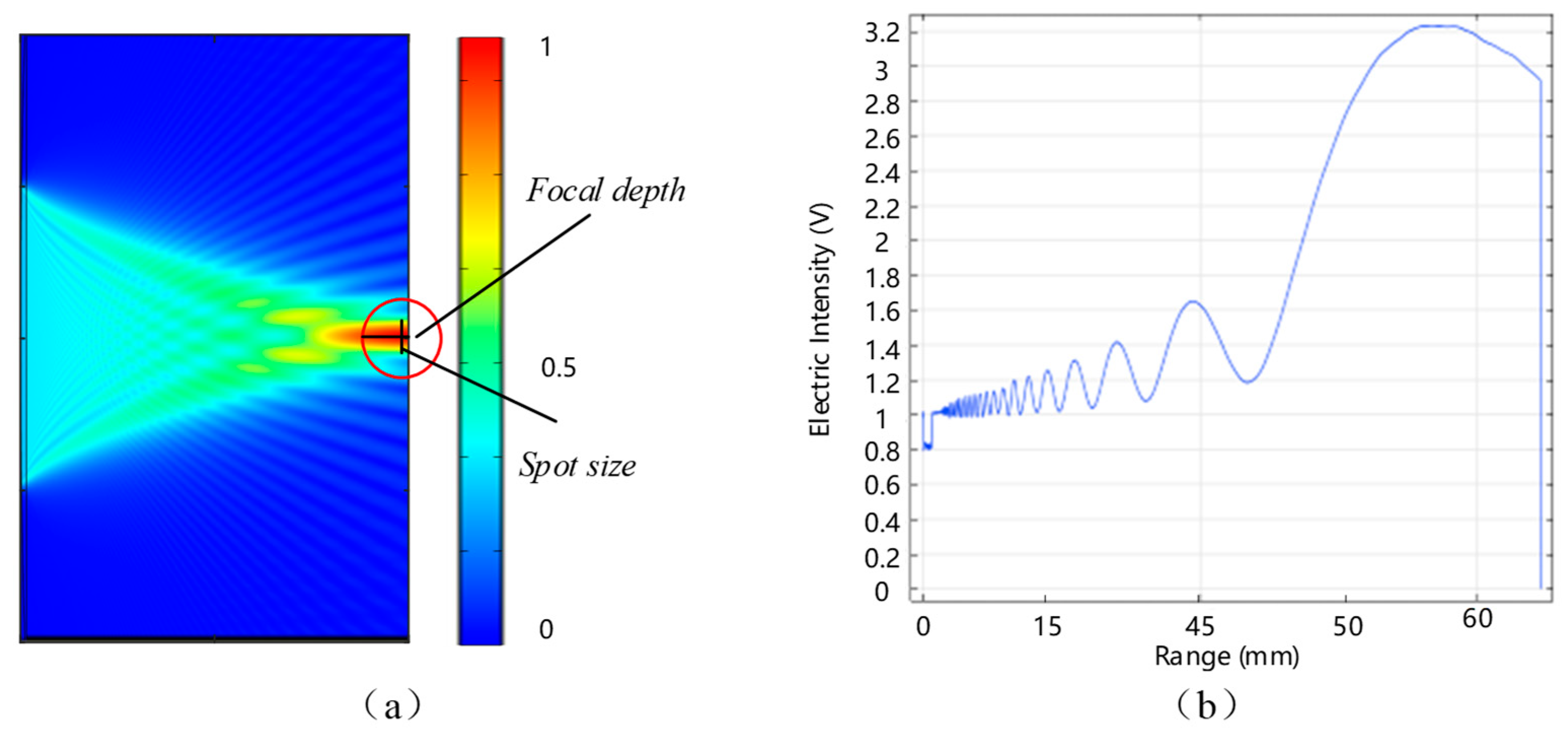
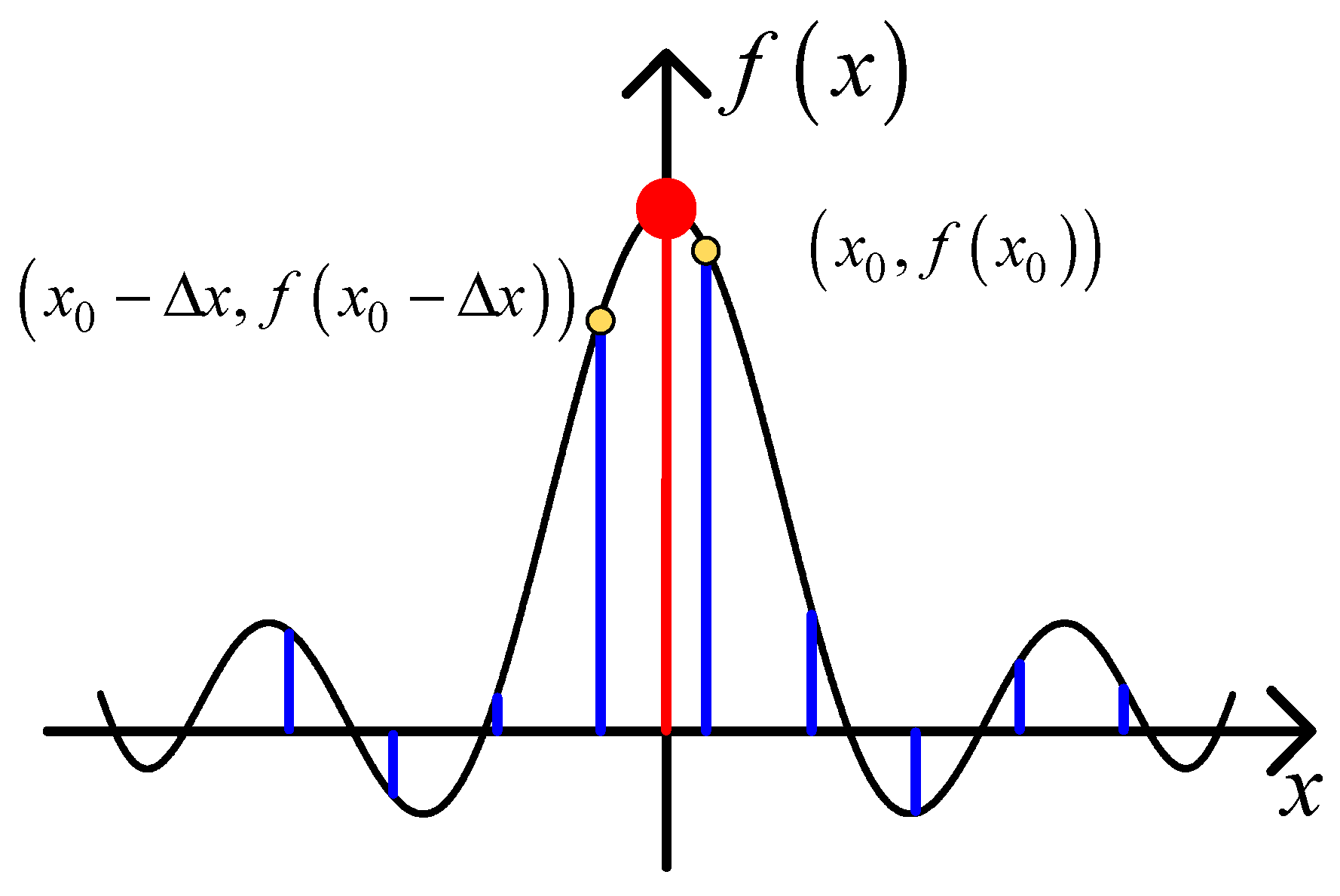

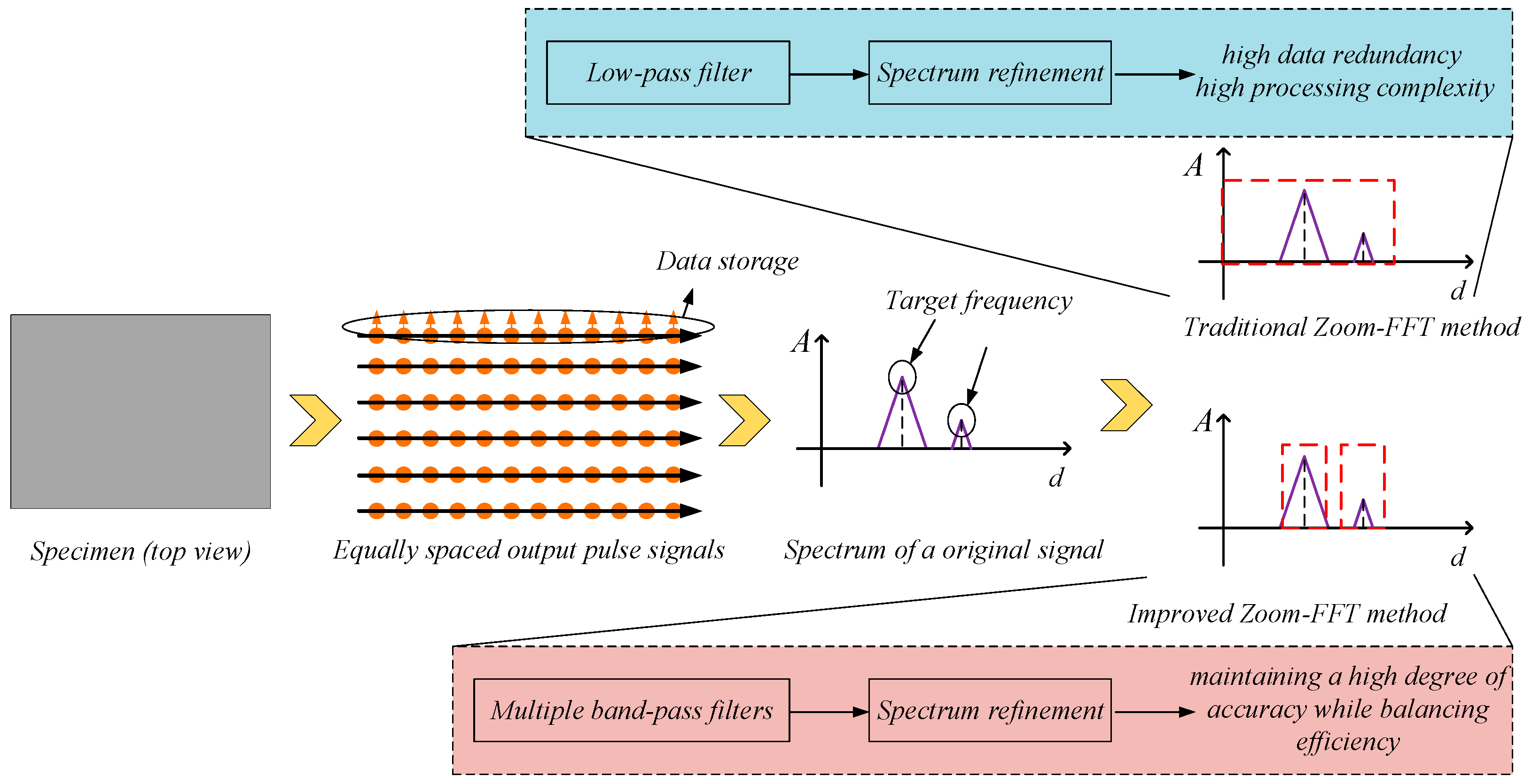

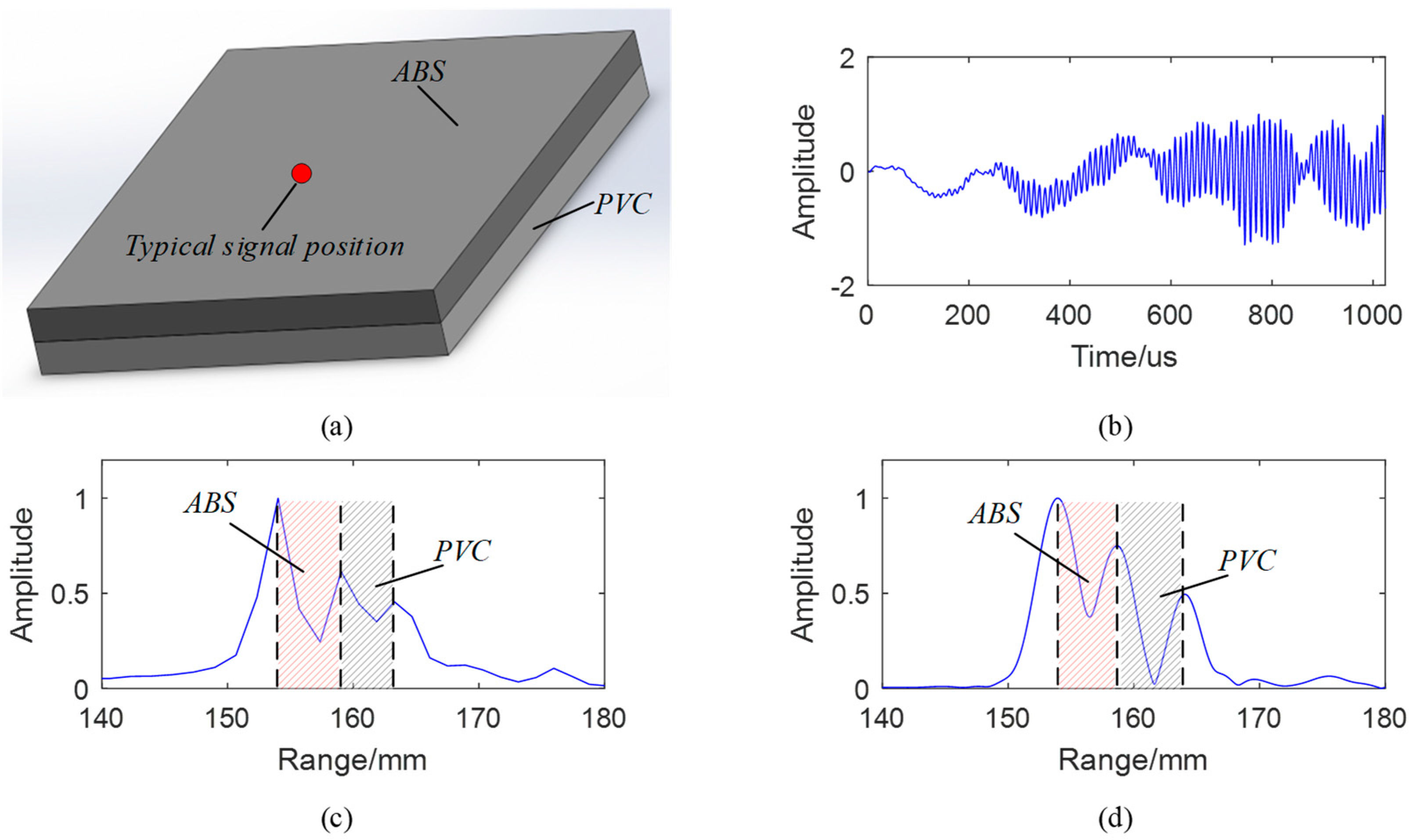

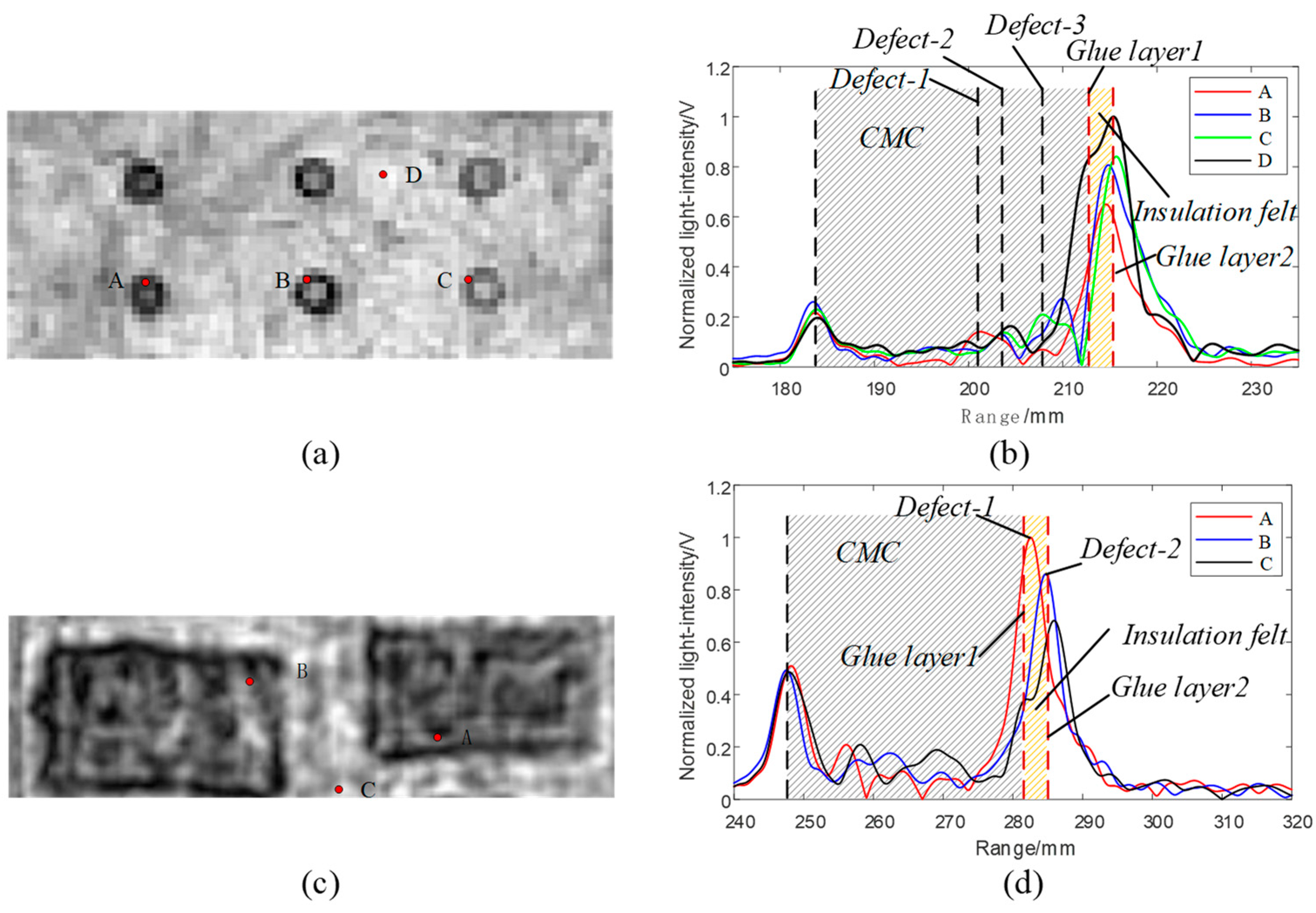
| Parameters | Value |
|---|---|
| Center frequency | 154 GHz |
| Bandwidth | 56 GHz |
| Sweep time | 1.024 ms |
| Sampling rate | 1 MHz |
| Maximum scanning area | 400 mm × 400 mm |
| Radiation power | 0.5 mW |
| Raster scanning clock | Start-stop-start |
| Operating mode | Active reflective |
| FM waveform | LFMCW |
| Application scenario | Laboratory and Field Testing |
| Distance Measurement | Thickness Measurement | |||||||
|---|---|---|---|---|---|---|---|---|
| Single Layer | Two Layers | |||||||
| Spectral Peak 1 | Spectral Peak 2 | Spectral Peak 1 | Spectral Peak 2 | Spectral Peak 3 | ||||
| Range (mm) | 50 | 60 | 63 | 50 | 60 | 50 | 60 | 63 |
| Theoretical frequency (Hz) | 18,229 | 21,875 | 22,969 | 18,229 | 21,875 | 18,229 | 21,875 | 22,969 |
| FFT | −321 | 395 | −471 | −321 | 395 | −321 | 395 | −471 |
| Zero-padding | −31 | −25 | −21 | 29 | −55 | 29 | 115 | −881 |
| Ratio method | 0 | 0 | 0 | −7 | 7 | −8 | −241 | 25 |
| Energy centrobaric method | −9 | 15 | −25 | −6 | 12 | −5 | 297 | −138 |
| FFT + FT | −16 | −10 | −6 | 19 | −55 | 49 | 55 | −211 |
| CZT | −11 | −5 | −1 | 19 | −55 | 49 | 55 | −211 |
| Proposed method | −1 | 5 | −1 | 19 | −50 | 42 | 49 | −181 |
| Methods | Computational Complexity |
|---|---|
| Ratio method | |
| Energy centrobaric method | |
| FFT + FT | |
| CZT | |
| Proposed method |
| Methods | ABS | PVC | ||||
|---|---|---|---|---|---|---|
| Real Thickness (mm) | Measured Thickness (mm) | Error (%) | Real Thickness (mm) | Measured Thickness (mm) | Error (%) | |
| FFT | 5.10 | 4.94 | 3.14 | 5.13 | 4.16 | 18.91 |
| Zero-padding | 5.10 | 4.80 | 5.88 | 5.13 | 5.4 | 5.26 |
| Ratio method | 5.10 | 4.74 | 7.06 | 5.13 | 5.39 | 5.07 |
| energy centrobaric method | 5.10 | 4.72 | 7.45 | 5.13 | 5.20 | 1.37 |
| FFT + FT | 5.10 | 5.45 | 6.86 | 5.13 | 4.32 | 15.79 |
| CZT | 5.10 | 4.81 | 5.69 | 5.13 | 4.32 | 15.79 |
| proposed method | 5.10 | 4.98 | 2.35 | 5.13 | 5.21 | 1.56 |
Disclaimer/Publisher’s Note: The statements, opinions and data contained in all publications are solely those of the individual author(s) and contributor(s) and not of MDPI and/or the editor(s). MDPI and/or the editor(s) disclaim responsibility for any injury to people or property resulting from any ideas, methods, instructions or products referred to in the content. |
© 2023 by the authors. Licensee MDPI, Basel, Switzerland. This article is an open access article distributed under the terms and conditions of the Creative Commons Attribution (CC BY) license (https://creativecommons.org/licenses/by/4.0/).
Share and Cite
Xue, K.; Zhang, W.; Wang, Z.; Jin, Y.; Guo, X.; Chen, Y. Real Aperture Continuous Terahertz Imaging System and Spectral Refinement Method. Photonics 2023, 10, 1020. https://doi.org/10.3390/photonics10091020
Xue K, Zhang W, Wang Z, Jin Y, Guo X, Chen Y. Real Aperture Continuous Terahertz Imaging System and Spectral Refinement Method. Photonics. 2023; 10(9):1020. https://doi.org/10.3390/photonics10091020
Chicago/Turabian StyleXue, Kailiang, Wenna Zhang, Zhaoba Wang, Yong Jin, Xin Guo, and Youxing Chen. 2023. "Real Aperture Continuous Terahertz Imaging System and Spectral Refinement Method" Photonics 10, no. 9: 1020. https://doi.org/10.3390/photonics10091020
APA StyleXue, K., Zhang, W., Wang, Z., Jin, Y., Guo, X., & Chen, Y. (2023). Real Aperture Continuous Terahertz Imaging System and Spectral Refinement Method. Photonics, 10(9), 1020. https://doi.org/10.3390/photonics10091020





